click on the home button to go to the home page
|
The Industrial Era 1947 - 1949 The First Generation of computers start approximately in this era and computers were characterized by electromechanical mechanisms and partly programmable. In this chapter the transister will be developed and the first stored program computers come on line |
pre history | antiquity |
pre industrial era | industrial
era
1947 - 1950
- 1952 - 1955 - 1958
- 1961 - 1963 - 1965
- 1969 - 1970 - 1972
- 1974 - 1976 - 1978
- 1980 - 1981 - 1982
- 1984 - 1986 -
1989 - 1991 - 1993 - 1994
- 1996 - 2000 - 2002
| Related Articles |
| Related Resources |
![]() The
first generation of modern programmed electronic computers was built in 1947.
This group included computers using Random Access Memory (RAM), a form of memory
designed to give almost instantaneous access to any information stored in memory.
Physically they were much smaller than the ENIAC, about the size of a large
piano and used only 2,500 electron tubes. Where the ENIAC
needed over 18,000. This group of computers included the Manchester
MARK-I, EDVAC and UNIVAC,
the first commercially available computers.(16)
The
first generation of modern programmed electronic computers was built in 1947.
This group included computers using Random Access Memory (RAM), a form of memory
designed to give almost instantaneous access to any information stored in memory.
Physically they were much smaller than the ENIAC, about the size of a large
piano and used only 2,500 electron tubes. Where the ENIAC
needed over 18,000. This group of computers included the Manchester
MARK-I, EDVAC and UNIVAC,
the first commercially available computers.(16)


![]() Fred
Williams an English professor, developed in cooperation with Tom
Kilburn, the first Random Access Memory - RAM - the Williams Tube. Its first
practical use will be for the Manchester
MARK-I computer in 1948.
Fred
Williams an English professor, developed in cooperation with Tom
Kilburn, the first Random Access Memory - RAM - the Williams Tube. Its first
practical use will be for the Manchester
MARK-I computer in 1948.
![]() Alan
Turing published an article on Intelligent Machinery which launched Artificial
Intelligence outside of the science fiction arena.
Alan
Turing published an article on Intelligent Machinery which launched Artificial
Intelligence outside of the science fiction arena.
![]() In October 1947,
the directors of J. Lyons & Company, a British catering company famous for
its teashops but with strong interests in new office management techniques,
decide to take an active role in promoting the commercial development of computers.(23)
Four years later in 1951 this effort will result
in the LEO I the first computer to run commercial software.
In October 1947,
the directors of J. Lyons & Company, a British catering company famous for
its teashops but with strong interests in new office management techniques,
decide to take an active role in promoting the commercial development of computers.(23)
Four years later in 1951 this effort will result
in the LEO I the first computer to run commercial software.
![]() The
magnetic drum is introduced as a low energy device that will replace the Williams
Tube in another few years. But the magnetic drum is still very unreliable and
prone to crashes.
The
magnetic drum is introduced as a low energy device that will replace the Williams
Tube in another few years. But the magnetic drum is still very unreliable and
prone to crashes.
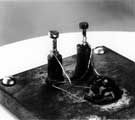
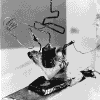
![]() At
the AT&T - Bell laboratories the TRANSISTOR [TRANsfer reSISTOR] was invented
by three Americans: Walter
H. Brattain, William Shockley
and John Bardeen. On 16 December
1947 the three showed their invention at the laboratories to a small public.
Bell laboratories patents the transistor.
At
the AT&T - Bell laboratories the TRANSISTOR [TRANsfer reSISTOR] was invented
by three Americans: Walter
H. Brattain, William Shockley
and John Bardeen. On 16 December
1947 the three showed their invention at the laboratories to a small public.
Bell laboratories patents the transistor.
This invention earned the three engineers the Nobel price(17) in 1956.
 |
 |
 (17) |
The transistor preluded the Second Generation and following generations of computers.
But much more research was needed to put the transistor into production what will take no less than six years to achieve that. (1) The small size, high yield, low heat production and the low price will guarantee the success of the transistor that will make computers another 1000 times faster than those on the market in this period.The US military is now informed about transistors, since they are paying for the bills. As they do with many other research groups in the USA. That developments sometimes do not always have peacefull effects is a natural by-effect to their kind of business. It is undeniable so that to this lavishly high level of military funding that developments in (digital) computing are spurting ahead.
![]() In this same
year two German scientists Herbert Matare and Heinrich
Welker invent parallel to Shockly and Brattain the junction transistor.
They work for the Compagnie des Freins et Signaux Westinghouse in France.
The patent is submitted 18th August 1948 and granted on 11 june 1952 under Brevet
d'Invention (patent) 1.010.427 of the French patent buro. (10)
In this same
year two German scientists Herbert Matare and Heinrich
Welker invent parallel to Shockly and Brattain the junction transistor.
They work for the Compagnie des Freins et Signaux Westinghouse in France.
The patent is submitted 18th August 1948 and granted on 11 june 1952 under Brevet
d'Invention (patent) 1.010.427 of the French patent buro. (10)
|
Burning out Computers so far mentioned are known as the first generation of computers. They were huge and needed sometime more than one floor of an average large building. Several thousands of vacuum tubes were mounted inside the computers, generating a tremendous heat. The disadvantage of computers running in this period was that they only worked correctly for a few hours in a row mainly caused by the pour quality of the tubes and the heat that was generated inside the machines. Tubes therefor easily burned out because of the heat and had to be replaced quite often. All computers started to work following the binary principle. Each tube
stood for "true" (1) or "false" (0). The computer
had to work through a series of tubes to execute an instruction from the
program and one can imagine that when a few tubes burned out the machine
would not work properly. A simple example is the ASCII alphabet invented
by a group of engineers at IBM in 1963 were each character is defined
by a combination of zero's and one's.
|
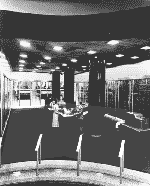
![]() 27
January; IBM shows the SSEC to the public in New York. Remarkable is that "C"
does not mean 'Computer' but 'Calculator'. (SSEC = Selective Sequence Electronic
Calculator) This indicates the difference between these two. The SSEC is the
first calculator to execute commands sequential and is able to change the program
depending on the results it produces during its processing. The SSEC is 250
times faster then the MARK I, but the machine still contains 12.500 tubes and
21.400 relays and is 36 meters long. Generating a lot of heat and noise.
27
January; IBM shows the SSEC to the public in New York. Remarkable is that "C"
does not mean 'Computer' but 'Calculator'. (SSEC = Selective Sequence Electronic
Calculator) This indicates the difference between these two. The SSEC is the
first calculator to execute commands sequential and is able to change the program
depending on the results it produces during its processing. The SSEC is 250
times faster then the MARK I, but the machine still contains 12.500 tubes and
21.400 relays and is 36 meters long. Generating a lot of heat and noise.
The development cost over one million US$ but IBM put the machine at the disposal
to scientists for free(7)
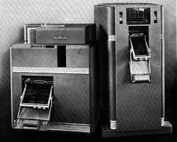
![]() IBM
brings out the IBM 604 model that contains only 1400 tubes. This one works relatively
slow and is capable of just about 70 program steps. The marketing analysts of
IBM estimate the market at 75 pieces. But before years end over 5.600 are installed.
IBM
brings out the IBM 604 model that contains only 1400 tubes. This one works relatively
slow and is capable of just about 70 program steps. The marketing analysts of
IBM estimate the market at 75 pieces. But before years end over 5.600 are installed.
In 1974 more than 400 of these machines will be still operation!(7)
![]() IBM is the
first manufacturer that translates machine maintenance into a modular system.
No longer vacuum tubes or other parts are replaced piece by piece but the machine
is assembled from modules. When a tube burns out a complete module is replaced
not the tube alone. This means repairing computers in minutes and not hours
as before. Back in the workshop maintenance engineers can look for the error
by using reference computers. They do that by replacing the components one by
one and look what goes wrong. The computer at the customers site is of course
already up and running again. This saved a lot of money and guaranteed a high
"up time"(11) as
system engineers like to say.
IBM is the
first manufacturer that translates machine maintenance into a modular system.
No longer vacuum tubes or other parts are replaced piece by piece but the machine
is assembled from modules. When a tube burns out a complete module is replaced
not the tube alone. This means repairing computers in minutes and not hours
as before. Back in the workshop maintenance engineers can look for the error
by using reference computers. They do that by replacing the components one by
one and look what goes wrong. The computer at the customers site is of course
already up and running again. This saved a lot of money and guaranteed a high
"up time"(11) as
system engineers like to say.

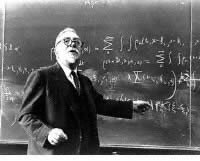 |
Norbert Wiener (USA) publishes his book "Cybernetics, or Control of Communication in Animal and Machine". This book is still one of the standard works in the field of Cybernetics.(3) |
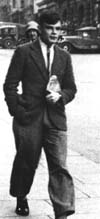 |
Alan Turing designs together with a few of his colleagues in the USA a theoretical computer called: ACE - Automatic Computing Machine. A universal calculator(12). But it will only exist on paper because it will never be build. |
|
An Wang invents the computer memory core. It will take him about three years to come with a marketable product. |
 (8) (8) |
![]() On 21 June
(UK) the first programmable computer at Manchester University, runs its first
program written in binary form by Prof.
Tom Kilburn.
On 21 June
(UK) the first programmable computer at Manchester University, runs its first
program written in binary form by Prof.
Tom Kilburn.
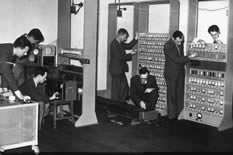
At the Cambridge university the EDSAC (Electronic Delay Storage Automatic Calculator) is designed and built by Maurice Wilkes and F.C. Williams, and the staff of the Mathematical Laboratory at Cambridge University. The machine is inspired by the Univac
The machine has acoustic memory storage tubes, oscilloscope displays and contained a so called library of subroutines designed by Wilkes. This library consist of small programs that are labeled subroutines. Probably this was the first attempt to create a so called Kernel(2). The EDSAC is considered to be the first full-scale stored program computer.(18) Most importantly it is the first computer that can store not only data but any user program in electronic memory and process it at electronic speed.(22)
Program and data both modifiable in storage, as suggested in Zuse's 1936 patent application but Zuse himself did not implement this technology in his Z1 Z2 and Z3 models.(21)
It is the first machine that has all the components now classically regarded as characteristic of the basic computer.
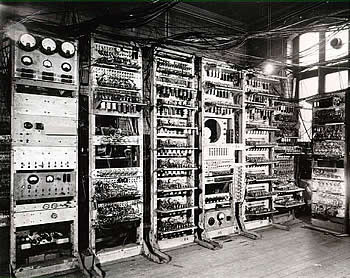
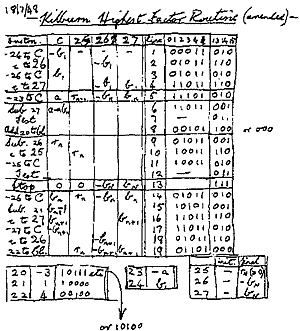
the Manchester Baby and its first computer program by Tom Kilburn
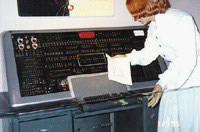
![]() Based
on the idea of the 'Stored Program Computer' Eckert and Mauchly found the UNIVAC
company that develop the UNIVAC-1 (UNIVersal
Automatic Computer). It is the first company that manufactures computers for
businesses on a large scale and that not being used for war purposes in the
first place. Forty six units will be build and sold for over 1 million dollars.
Since this machine makes use of the stored program technology rewiring circuits
and setting switches to execute a program had become obsoleted. This machine
received its instructions directly from the stored program itself. The short
code developed for the UNIVAC 1 was both the first interpreted language
and the first assembly language. (18)
Based
on the idea of the 'Stored Program Computer' Eckert and Mauchly found the UNIVAC
company that develop the UNIVAC-1 (UNIVersal
Automatic Computer). It is the first company that manufactures computers for
businesses on a large scale and that not being used for war purposes in the
first place. Forty six units will be build and sold for over 1 million dollars.
Since this machine makes use of the stored program technology rewiring circuits
and setting switches to execute a program had become obsoleted. This machine
received its instructions directly from the stored program itself. The short
code developed for the UNIVAC 1 was both the first interpreted language
and the first assembly language. (18)
Univac will later be sold to the Remington Rand Corp.
![]() December; the
Harvard Mark II is operational(7)
December; the
Harvard Mark II is operational(7)
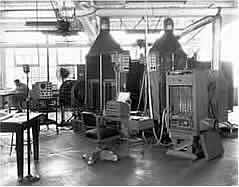
![]() BINAC
Binary Automatic Computer; this computer is made by the company of Eckert
en Mauchly and one of the first
computers that made use of magnetic tape. It is the first computer to operate
in real time.
BINAC
Binary Automatic Computer; this computer is made by the company of Eckert
en Mauchly and one of the first
computers that made use of magnetic tape. It is the first computer to operate
in real time.
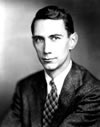
![]() Claude
Shannon of MIT builds the first chess playing machine but will never exploit
it.
Claude
Shannon of MIT builds the first chess playing machine but will never exploit
it.
![]() From the Small-Scale
Experimental Machine (also called the "Baby") a full-sized machine
was designed and built, the Manchester MARK-1
, which by April 1949 will be generally available for computation in scientific
research in the University. With the integration of a high speed magnetic drum
by the Autumn (the ancestor of today's hard disk) this is the first machine
with a fast electronic and magnetic two-level store. It in turn is the basis
of the first commercially available computer, the Ferranti Mark 1, the first
machine off the production line being delivered in February 1951.(22)
From the Small-Scale
Experimental Machine (also called the "Baby") a full-sized machine
was designed and built, the Manchester MARK-1
, which by April 1949 will be generally available for computation in scientific
research in the University. With the integration of a high speed magnetic drum
by the Autumn (the ancestor of today's hard disk) this is the first machine
with a fast electronic and magnetic two-level store. It in turn is the basis
of the first commercially available computer, the Ferranti Mark 1, the first
machine off the production line being delivered in February 1951.(22)
![]() First Germanium
transistors sold.
First Germanium
transistors sold.
![]()
| Last Updated on October 20, 2004 | For suggestions please mail the editors |
Footnotes & References